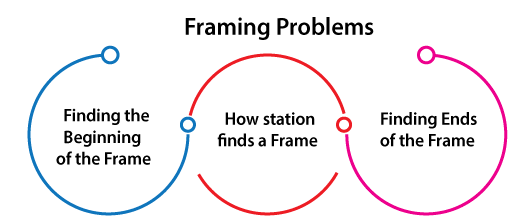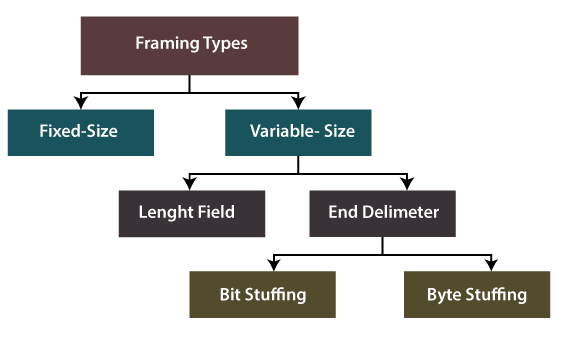Frame Definition
A frame can be defined as the digital data transmission unit in telecommunication and computer networking. A frame is a straight-forward network packet in the packet-switched systems. A frame is a repeating structure that supports time-division multiplexing in other types of telecommunication systems.
Typically, a frame contains frame synchronization benefits including a sequence of symbols or bits. It shows the starting and completion of the payload data in the bits and symbols stream it receives. When a receiver is linked to the system at the time of frame transmitted. It avoids the information until it finds a new frame coordination sequence.
Packet Switching
A frame has been defined as a protocol data unit on the data link layer in the computer networking OSI model. These frames are an outcome of the encapsulation's final layer before the information is moved to the physical layer. The frames are the transmission unit at the link-layer protocol.
It combines the header of a link-layer followed by a single packet. All the frames are isolated from the next frame through the inter-frame gap. Generally, a frame is a sequence of bits consisted of the frame coordination bits such as a frame check sequence and the packet payload.
Examples are V.42 modem frames, Fibre Channel Frames, PPP (Point-to-Point) Frames, and Ethernet Frames.
Often, different sizes of frames are nested in each other. The eight bits of all individual bytes can be framed by stop and start bits if using PPP (Point-to-Point) on asynchronous serial communication.
The payload data bytes are framed by the footer and header in a network packet. And various packets could be framed using frame boundary octets.
Time-division Multiplex
Specifically, in time-division multiple access (TDMA), time-division multiplex (TDM), and telecommunications variants, a frame has been defined as a constantly repeated block of data that includes the fixed number of various time slots, a single for all logical TDMA transmitter TDM channel.
Typically, a frame is an entity in this context on the physical layer. Some examples of TDM applications are ISDN circuit-switched B-channel and SDH/SONET, while some of the examples of TDMA are Circuit Switched Data applied in previous cellular voice services.
Also, the frame is an individual for a time-division duplex. Besides, the mobile terminal might transmit during a few time slots and get during others.
Framing Problems

- Finding the Beginning of the frame: All stations should be able to find the frame when it is transmitted. Station finds many frames by seeing out for a unique series of bits that points to the starting of the frame such as SFD (Starting Frame Delimeter).
- How station finds a frame: All stations listen to connected for SFD style by a sequential circuit. These sequential circuits inform the station when SFD is found. Station inspects destination address to reject or accept a frame.
- Finding End of the Frame: When to finish reading a frame.
Framing Types

Two of the primary types of framing are discussed below:
- Fixed-size: The first type of frames is of fixed size. There is no requirement to give boundaries to any frame because frame length behaves as a delemiter itself.
- Drawback: It goes through internal fragmentation when the size of data is less than as compared to the size of the frame.
- Quick Fix: Padding
- Variable Size: There is no requirement to describe frame end as well as starting of the upcoming frame to characterize this type of framing. It could be implemented in two different forms:
- Length field: In a frame, we can define the length field to show the length of a frame. It is applied in the Ethernet (802.3). The issue with it is that the length field may get corrupted sometimes.
- ED (End Delimeter): In a frame, we can address an end delimeter to show the completion of a frame. It is applied in the Token Ring. The issue with it is that the end delimeter can appear in the data.
- Bit Stuffing: An arrangement of bits of random length can be stuffed in a message for differentiating through the delimeter. Also, it is known as bit-oriented framing.
- Byte Stuffing: The bytes are stuffed in a message for differentiating through the delimeter. Also, it is known as character-oriented framing.
Advantages of frames
- A frame can be defined as the data in telecommunications that are moved between various network points as any unit end with essential protocol control data and addressing. Usually, a frame is moved bit-by-bit serially and includes a trailer field and header field that frame the information. (A few control frames include no information).
- A frame is the event's complete cycle within the period division in time-division multiplexing.
- In playback, video, and film recording, a frame is a general image in a series of images that can be played back and recorded.
- In the computer video display method, a frame is an image that is transferred to a display image delivering device. Continuously, it is refreshed and updated through the frame buffer. It is a highly accessible video RAM part.
- In Artificial intelligence applications, the frames are a group of data along with details about a specific image, process, and object. An example of this type of frame is the iris-print visual recognition system utilized to recognize users of various bank ATMs. This system then compares the data frame for a user using the frame within its authorized user's database.
Data Link Layer Framing
Data transmission associates bits synchronized transmission through a source to a destination. This data link layer stores these bits into the frames.
This layer holds the packets through the Network layer and envelopes them into the frames. When the size of a frame becomes large, then a packet might be categorized into a small size of frames. These smaller sized frames enable error control and flow control more efficient.
It then sends all frames over the hardware bit-by-bit. The data link layer takes the signals through hardware and gathers them into many frames at the end of the receiver.
Frames Parts
A frame contains some parts which are mentioned as follows:
- Flag: It points to the starting and completion of the frame.
- Trailer: It includes the error correction and end detection bits.
- Payload field: It includes the messages to be rendered.
- Frame Header: It includes the origin and the target addresses of a frame.
Frame Header
It includes the source address, destination address, and three of the main control fields such as ack, seq, and kind. These fields are discussed below:
- ack: It includes the acknowledgment number of a few frames when piggybacking is applied particularly.
- seq: It includes the sequence number of a frame for re-adjustment of various out-of-sequence frames. This field is also used for sending acknowledgments through the receiver.
- kind: It includes states whether a frame is any data frame or the frame is applied for many control functions such as link management or flow and error control etc.
Need for frames
- The frame is the digital transmission's units in telecommunications and computer network particularly.
- In case of the energy, frames are proportionate to the energy packets known as photons.
- Continuously, frames are used in process of time-division multiplexing.
- The framing process is a Point-to-Point connection between two devices or computers that combine the wire where the data is moved as various bits streams.
- However, the bits should be frames into visible data blocks. Framing can also be described as the data link layer function.
- It facilitates a form to a sender for transmitting a group of bits that are valid for a receiver.
- Frame relay, token ring, Ethernet, and other types of data link layer methods have their frame structures.
- Also, frames contain headers that include information like error-checking codes.
- It is beneficial to use the frames because the data is divided into various recoverable parts that can be inspected for corruption easily.
- The data link layer categorizes the datagram and translates them into capable for transfer. It is known as framing.
- It facilitates two of the primary functionalities:
- It provides a mechanism for flow control that manages the frame flow such that the congestion of data is not there on slow receivers because of the fast senders.
- It provides reliable transfer services of data between two layers of the peer network.
|


 For Videos Join Our Youtube Channel: Join Now
For Videos Join Our Youtube Channel: Join Now









